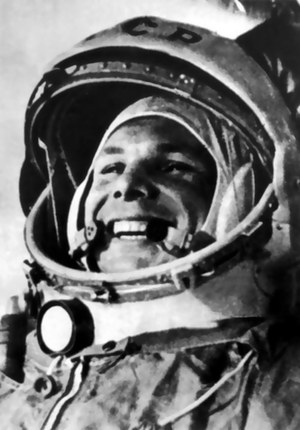Ushering in the final frontierby Ayodele Faiyetole
|
| New opportunities are now open to all: even African nations now have recognizable participation in small satellites and astronomy. |
Exactly twenty years after this flight, on April 12, 1981, the American Space Shuttle program had its first flight. Columbia launched astronauts John W. Young, an Apollo veteran who, in 1972, was the ninth person to walk on the Moon, and Robert L. Crippen to space on mission STS-1. April 12 wasn’t deliberately chosen for this launch: the original planned date had slipped for technical issues. Until their retirement with the final flight of Atlantis on STS-135 last July, these reusable space vehicles were the flagship of manned spaceflight.
Twenty years after the launch of STS-1, and forty years after Gagarin’s flight, in 2001, “Yuri’s Night” was started to commemorate this flight of the Columbus of the Cosmos, and to mark this launch of Columbia. It will be held on April 12 across the globe by space enthusiasts and institutions, especially in the US and Russia. And I am proud to mention here that the co-founder of this spectacular night, Loretta Hidalgo-Whitesides, was the recipient of the inaugural Todd B. Hawley Visionary Award in 2005.
The International Space University, with its permanent site in Strasbourg, France, has been the academic home of space professionals and a training ground for emerging space leaders across the globe. ISU’s first program, the space studies program, started in MIT and has moved to most continents of the world. It was founded by its three visionaries: Peter H. Diamandis, Todd B. Hawley, and Robert D. Richards in 1987. The institution’s credo was written out by these visionaries on April 12, 1995.
This year, ISU celebrates its 25th year: the silver jubilee of actively producing space leaders that have gone on to shape the future of space programs and activities on Earth and in the cosmos. ISU is even more determined to establish, by 2040, an “off-Earth campus to form a core element of the University’s educational and societal actions related to exploration and technology development.”
In 2007, the international space community, led by the United Nations, commemorated 50 years of active space exploration, marking the launch of the first satellite, Sputnik 1. Serving as a National Coordinator for Education and Public Outreach of this UN-led program, the International Heliophysical Year, I marked April 12 and explored the ideals of a concept I called the “scientific but people-oriented education, SPOE: Art and Humanities in Science and Technologies”. A scientific education and outreach program was organized for a public model school in Lagos, Nigeria, captured in a national daily. And in collaboration with Stanford University, live research equipment was demonstrated for the students, educating them about the Sun, human spaceflight, and exploration. I taught them about the encompassing nature of knowledge, thus softening the science with art. The students received talks on world citizenry and career possibilities that culminated in a Q & A session. We went ahead to dance to popular local tunes! And the results? The students got inspired: they wanted to become everything from astronauts to surgeons, engineers, scientists, and even a “space artist.” Some of them are already in some leading universities preparing for their dream careers, and are being guided under the Young EarthSpace Scientists (YESS) program.
| To usher in this next future—the final frontier—these three significant occurrences of Gagarin’s flight, STS-1, and the founding of ISU are enough to seal the 12th of April as the “World Manned Spaceflight Day”. |
There’s an emergence of a new human spaceflight order. The flawless docking between Shenzhou-8 and Tiangong-1 (a prototype space station) in 2011 laid a foundation for human spaceflight in China. Shenzhou-9 is expected to launch later this year the first people to its “Heavenly Palace,” and the crew may include the first female taikonaut. India has been really inspiring too, with their scientific satellites and launch vehicles programs, also shooting for the Moon. New opportunities are now open to all: even African nations now have recognizable participation in small satellites and astronomy. Last year, for the first time ever, the International Astronautical Congress took place in Africa.
We are indeed in a golden era of active space exploration. The scientific research community now has unprecedented opportunities to contribute to international standard research. The ISS is delivering dividends to its owners and, by extension, to the scientific community worldwide. There is an emerging suborbital industry. Private companies are now venturing beyond suborbital as well, building rockets that may reach the other planetary bodies. Elon Musk is set to be the first entrepreneur to put a human in orbit. What exciting times we are in.
In essence, to usher in this next future—the final frontier—these three significant occurrences of Gagarin’s flight, STS-1, and the founding of ISU are enough to seal the 12th of April as the “World Manned Spaceflight Day”. This could mean having a more holistic program planned for this day, programs that could encompass the ideals of manned spaceflight, exploration, and education in the daytime. And, of course, in the evening we can further popularize the social event of Yuri’s Night, which has done so much in making this day very popular worldwide. This is not to undermine the UN-supported “World Space Week” of October 4, which technically marked the launch of Sputnik. Space is vast, and in order for humans to further take the giant leaps of settling other worlds we need to ensure the growth of humans into multiplanetary beings and, therefore, we must provide some more emphasis to human spaceflight. We can start by dedicating April 12 of every year to human spaceflight in its entirety.
